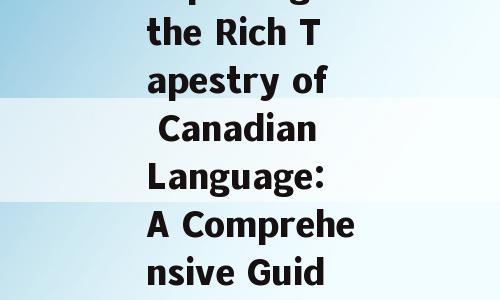Introduction:
Canada, a nation known for its multicultural diversity, boasts a unique linguistic landscape that reflects its history and cultural influences. From English and French to Indigenous languages and various immigrant tongues, the Canadian language is a vibrant mix that shapes the country's identity. In this comprehensive guide, we delve into the fascinating world of Canadian language, exploring its intricacies, significance, and the challenges it faces.
Paragraph 1: The Official Languages of Canada
Canada recognizes two official languages: English and French. English is predominantly spoken in the provinces of Ontario, Quebec, New Brunswick, Nova Scotia, Prince Edward Island, and Newfoundland and Labrador. French, on the other hand, is the official language of Quebec and is also widely spoken in New Brunswick. This linguistic duality is a testament to Canada's commitment to multiculturali *** and linguistic rights.
Paragraph 2: Indigenous Languages
Indigenous languages have been an integral part of Canada's cultural heritage for thousands of years. There are approximately 60 Indigenous languages spoken across the country, with many facing the threat of extinction. Efforts are being made to preserve and revitalize these languages through language nests, immersion programs, and educational initiatives. The Indigenous languages not only hold historical significance but also provide a unique perspective on Canadian culture.
Paragraph 3: Immigrant Languages
Canada is a nation of immigrants, and the languages spoken by new Canadians contribute to the country's linguistic diversity. Spanish, Arabic, Tagalog, Punjabi, and Chinese are among the most common languages spoken by immigrants in Canada. These languages are often spoken at home and within the community, creating a rich tapestry of cultural expression and communication.
Paragraph 4: Multilinguali *** in Education
The Canadian education system emphasizes the importance of multilinguali *** . French immersion programs are available in many provinces, allowing students to learn French alongside English. Additionally, Indigenous languages are increasingly being integrated into the curriculum, ensuring that future generations have access to their cultural heritage. This focus on multilingual education promotes cultural understanding and fosters a sense of belonging among diverse communities.
Paragraph 5: The Canadian Language Museum
The Canadian Language Museum is a unique institution dedicated to preserving and promoting the country's linguistic heritage. Through exhibits, interactive displays, and educational programs, the museum showcases the diverse languages spoken in Canada. It serves as a valuable resource for students, educators, and anyone interested in learning more about the nation's linguistic landscape.
Conclusion:
The Canadian language is a dynamic and ever-evolving entity that reflects the country's rich cultural diversity. From the official languages of English and French to the numerous Indigenous and immigrant languages, Canada's linguistic landscape is a testament to its commitment to multiculturali *** and linguistic rights. By preserving and promoting these languages, Canada continues to celebrate its unique identity and foster a sense of unity among its diverse population.
References:
- Statistics Canada. (2021). Aboriginal languages in Canada. Retrieved from https://www12.statcan.gc.ca/census-recensement/2016/dp-pd/hlt-fst/p16/ablang-eng.cfm
- Canadian Language Museum. (n.d.). About us. Retrieved from https://canadalanguage.ca/
- UNESCO. (2019). Indigenous languages in Canada. Retrieved from https://en.unesco.org/themes/indigenous-languages/case-studies/canada















还没有评论,来说两句吧...